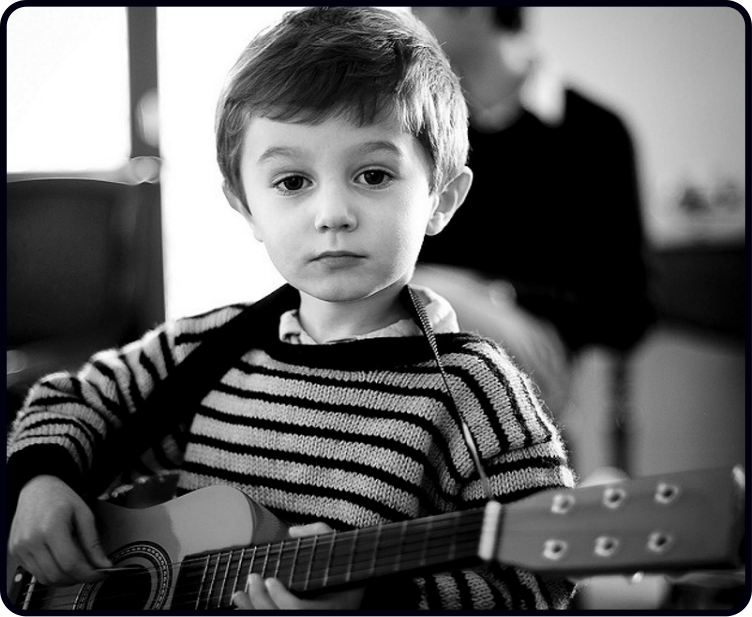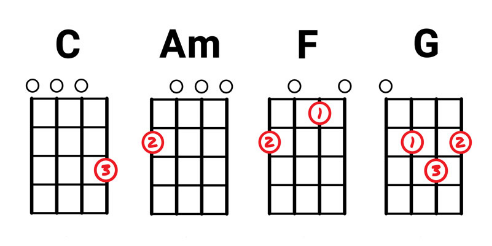
Serious guitarist iz serious by Frédéric de Villamil, licensed under (CC BY-SA 2.0)
In this post, I want to give you some guitar lessons for kids so you can share your guitar skills with the kids or grandkids in your life. This will allow you to share the joy of your guitar playing with a loved one and as a bonus, improve your knowledge and skills at the same time. Everyone’s a winner!
Many of my regular readers are above the age of 50 and many of you have grandkids and in some cases great grandkids!
Guitar lessons for kids (and adults can do them too!)
We have all been there, trying to get some good practice in and the little dude or diva in your life, is pestering you and tugging on the strings or trying to detune your guitar when you’re playing. If that’s the case, it’s often a sign they want to learn, which is a great opportunity to get them started.
Nearly all children are awed (just like the rest of us) by this super cool and amazing instrument at some point in their lives. If they see a loved one playing something they know these feelings of awe often go into overdrive.
Lesson 1 – Get them strumming while you play the chords
One of my favourite things to do to involve a child in chord based guitar playing when they can’t actually play chords is to fret the chords to a song while getting them to strum the chords.
I have used this lots with young family members over the years and it is a great way to make music with them. This is because they will struggle with getting chords to sound good as we all do in the early days, but whereas an adult will usually have the determination to push past this, a child might give up way before this point.
Therefore, choosing a song, and getting them to play a really simple strum pattern such as D, D, D, D, – basically four downstrums on the beat, while you do the chords and changes is a great way to go.
Pick any song, ideally, one they know, and they will love being involved. Get them to strum the chords to a steady rhythm and it will sound musical.
Try to make it a fairly modern one that they will know from the radio/Spotify or a classic nursery rhyme if they are a little younger.
Here are the chords to one of the simplest of them all… “Row, row, row your boat”…
It’s four strums each time you see a chord except the D7 and the last G where they are a split bar of two strums each.
Lesson 2 – Get them to fret a couple of notes
The opposite to the above is for you to get the child to fret a note on the guitar, ideally on the high E string as this is usually easiest for them, while you play a rhythm on this note. Once you play the rhythm for one bar, get them to change notes.
Any scale notes on the high E string (or any other string you choose) such as the 3rd and 5th frets along with the open string will work great.
Just make the rhythm you choose an interesting one. A tip here if you are not sure what rhythm to play, is to take the exact rhythm of a strum pattern you know, let’s say, the Ultimate strum pattern, and play it on this one string while still using the correct order of downs and ups.
Here is an example of this.
This is a good test of your ability to take a rhythm from a strum pattern and apply it to one string which can be a little tricky at first. It sounds good though and will help keep the child interested for the next lesson…
Lesson 3 – One string melodies
Now we can take things further and get the child to use both hands at the same time but still using just one string. A really simple melody that they will know and recognise is key here.
What better song to choose from than ‘Happy Birthday’. It is one that pretty much the whole world knows and if the child is anything like my boy, Archie, then they will love singing it.
Get them playing it in a really simple way as shown below. The key thing is to encourage them to sing along, so make sure you sing along with them playing it too.
Over time you can, of course, teach them how to arrange a melody like this so it sounds super sophisticated. You can do this one step at a time as I teach in my simple guide, ‘How To Create Beautiful Fingerstyle Arrangements Of Your Own’ currently only available as part of my membership programme.
As always, start simple and then teach them how to build the melody up over time and you will not only encourage them with a piece they know and love but you will teach them how you can continually improve even the most simple melody.
Lesson 4 – Give them a ukulele
A great gateway instrument for the guitar and one that is especially awesome for kids is the ukulele. This is because the uke has soft nylon strings, is small in size and has only four strings.
Most ukes, apart from the premium ones are not great and can sound rubbish but the good news is that with a decent set of strings and regular tuning they can sound pretty decent. I paid £30 for a ukulele many years ago, spent £10 on some good Aquila strings, and it instantly sounded 10 x better.
Just make sure you tune it regularly, as the short scale length (which means the length of the strings) can make the instrument go out of tune faster than you can sing the first line of ‘Old Macdonald’.
Once they get their uke, teach them the C and A minor chords as seen below and jam them with them.
Lesson 5 – “Semi Chords”
Taking lesson #4 to the guitar we can be inspired by ukulele chords and start off by playing four string versions of chords we are all supposed to learn.
Although kids should at first stay away from chords on the guitar, semi chords are a good way to get them started. Instead of playing the G, C and E minor chords in the conventional way, get them to play the semi chord version where you essentially ignore the low E and A strings.
Here is the standard version of the chords to the left and to the right is the semi versions. They are much easier.
Eventually, you can teach them the full versions of these chords but there is no rush at all for this.
There you go.
Five simple, fun and highly effective lessons you can use to teach that pesky child who keeps trying to detune your guitar when you are playing.
I always advise parents never to push the guitar on to a child as this can cause feelings of resentment towards the instrument.
You, like many others, were probably encouraged to play a classical instrument such as the oboe, flute or piano at some point in your life, often taught by someone who took the instrument very seriously and made learning a little dull.
This was probably very off-putting for you and might have kicked the joy out of learning – especially if you were taught pieces that you had no emotional connection to or didn’t recognise.
This brings me on to an important point…
…Encourage the child, but don’t push them into it and when you do teach them something, make it something they love and at least recognise.
Do that and you might well succeed where many have failed and you may just get them to fall in love with this great instrument just like you did and what a gift that is to a child you love.






For all the kids, guitar lessons can keep them motivated at certain times in comparison to others when it comes to practice of the guitar. There might be challenges as well as difficulties while learning the new things on any kind of instrument. The primary key to this is by overcoming the challenges through sheer determination and practicing, which thereby helps to build the confidence of the child.
Oh yeah, Biplab, lessons are great for all ages including kids but it really helps if the teacher has experience of teaching kids as they often talk much less than adults and require a different repertoire of songs but as long as the teacher has the above and keeps it fun (which it should be no matter what age) then the child will no doubt love it!
[…] There’s so much music in the world, if you’re not enjoying a piece of music – let it go. If you’re not enthusiastic about what you’re playing, you’re not actually […]
[…] learn simpler, easier pieces of music, and in fact, searching for easy kids guitar songs is a good way to […]